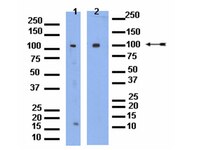DNMT1 modulates gene expression without its catalytic activity partially through its interactions with histone-modifying enzymes.
Clements, EG; Mohammad, HP; Leadem, BR; Easwaran, H; Cai, Y; Van Neste, L; Baylin, SB
Nucleic acids research
40
4334-46
2012
Show Abstract
While DNA methyltransferase1 (DNMT1) is classically known for its functions as a maintenance methyltransferase enzyme, additional roles for DNMT1 in gene expression are not as clearly understood. Several groups have shown that deletion of the catalytic domain from DNMT1 does not abolish repressive activity of the protein against a reporter gene. In our studies, we examine the repressor function of catalytically inactive DNMT1 at endogenous genes. First, potential DNMT1 target genes were identified by searching for genes up-regulated in HCT116 colon cancer cells genetically disrupted for DNMT1 (DNMT1(-/-) hypomorph cells). Next, the requirement for DNMT1 activity for repression of these genes was assessed by stably restoring expression of wild-type or catalytically inactive DNMT1. Both wild-type and mutant proteins are able to occupy the promoters and repress the expression of a set of target genes, and induce, at these promoters, both the depletion of active histone marks and the recruitment of a H3K4 demethylase, KDM1A/LSD1. Together, our findings show that there are genes for which DNMT1 acts as a transcriptional repressor independent from its methyltransferase function and that this repressive function may invoke a role for a scaffolding function of the protein at target genes. | | 22278882
 |
LSD1 demethylates repressive histone marks to promote androgen-receptor-dependent transcription.
Metzger, Eric, et al.
Nature, 437: 436-9 (2005)
2005
Show Abstract
Gene regulation in eukaryotes requires the coordinate interaction of chromatin-modulating proteins with specific transcription factors such as the androgen receptor. Gene activation and repression is specifically regulated by histone methylation status at distinct lysine residues. Here we show that lysine-specific demethylase 1 (LSD1; also known as BHC110) co-localizes with the androgen receptor in normal human prostate and prostate tumour. LSD1 interacts with androgen receptor in vitro and in vivo, and stimulates androgen-receptor-dependent transcription. Conversely, knockdown of LSD1 protein levels abrogates androgen-induced transcriptional activation and cell proliferation. Chromatin immunoprecipitation analyses demonstrate that androgen receptor and LSD1 form chromatin-associated complexes in a ligand-dependent manner. LSD1 relieves repressive histone marks by demethylation of histone H3 at lysine 9 (H3-K9), thereby leading to de-repression of androgen receptor target genes. Furthermore, we identify pargyline as an inhibitor of LSD1. Pargyline blocks demethylation of H3-K9 by LSD1 and consequently androgen-receptor-dependent transcription. Thus, modulation of LSD1 activity offers a new strategy to regulate androgen receptor functions. Here, we link demethylation of a repressive histone mark with androgen-receptor-dependent gene activation, thus providing a mechanism by which demethylases control specific gene expression. | | 16079795
 |
Histone demethylation mediated by the nuclear amine oxidase homolog LSD1.
Shi, Yujiang, et al.
Cell, 119: 941-53 (2004)
2004
Show Abstract
Posttranslational modifications of histone N-terminal tails impact chromatin structure and gene transcription. While the extent of histone acetylation is determined by both acetyltransferases and deacetylases, it has been unclear whether histone methylation is also regulated by enzymes with opposing activities. Here, we provide evidence that LSD1 (KIAA0601), a nuclear homolog of amine oxidases, functions as a histone demethylase and transcriptional corepressor. LSD1 specifically demethylates histone H3 lysine 4, which is linked to active transcription. Lysine demethylation occurs via an oxidation reaction that generates formaldehyde. Importantly, RNAi inhibition of LSD1 causes an increase in H3 lysine 4 methylation and concomitant derepression of target genes, suggesting that LSD1 represses transcription via histone demethylation. The results thus identify a histone demethylase conserved from S. pombe to human and reveal dynamic regulation of histone methylation by both histone methylases and demethylases. | Immunoblotting (Western) | 15620353
 |
A candidate X-linked mental retardation gene is a component of a new family of histone deacetylase-containing complexes.
Hakimi, Mohamed-Ali, et al.
J. Biol. Chem., 278: 7234-9 (2003)
2003
Show Abstract
Eukaryotic genes are under the control of regulatory complexes acting through chromatin structure to control gene expression. Here we report the identification of a family of multiprotein corepressor complexes that function through modifying chromatin structure to keep genes silent. The polypeptide composition of these complexes has in common a core of two subunits, HDAC1,2 and BHC110, an FAD-binding protein. A candidate X-linked mental retardation gene and the transcription initiation factor II-I (TFII-I) are components of a novel member of this family of complexes. Other subunits of these complexes include polypeptides associated with cancer causing chromosomal translocations. These findings not only delineate a novel class of multiprotein complexes involved in transcriptional repression but also reveal an unanticipated role for TFII-I in transcriptional repression. | | 12493763
 |












